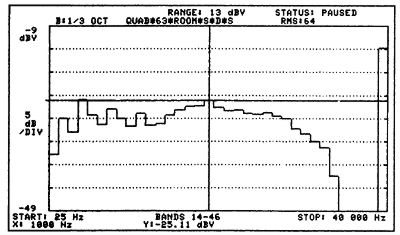

MartinLogan CLS loudspeaker
John Atkinson & Various, September, 1986


M-L's first model, the elegant Monolith, coupled an electrostatic treble and mid panel to a conventional dynamic woofer. I first heard this speaker in the Threshold room at a Summer CES some years back; the clarity was stunning. The CLS—the acronym stands for Curvilinear Line Source; I think that Clear LoudSpeaker would be just as appropriate—is the Kansas company's first full-range electrostatic, and again an elegant design, standing 5' tall. The most visually striking aspect of the CLS is its apparent simplicity: the Mylar diaphragm, just 2µm thick and with a total mass less than that of one cubic inch of air, is suspended between the two metal-plate stators, coated with black insulating paint, and punched with a matrix of holes to allow the sound to "escape." The diaphragm operates in push-pull, so should operate with low distortion.
And that's it, apart from a real-wood frame surrounding the diaphragm assembly and the box of electronics on the rear. No protective screen to keep the high voltages away from prying fingers; no dust cover that could introduce another set of HF resonances; nothing to get between the loudspeaker's moving element and the listener's ear. The unique aspect of the design, however, is the fact that, whereas other full-range electrostatics consist of flat panels, the CLS, like the Monolith, has a gently curved diaphragm. Exactly how this is done is M-L's proprietary process—though I know for a fact that Dorothy brought the secret back to Kansas from Oz—but the one-piece diaphragm is broken up into a number of different-sized, discrete horizontal elements by insulating damping strips, with long vertical strips running the full height of the speaker either side of the central array to preferentially handle low frequencies.
The reason for this techno-trickery is to avoid the beaming that accompanies a sound-source reproducing frequencies with wavelengths on the order of, or less than, the size of the source. Acoustat and Audiostatic attempt to overcome this problem by making the diaphragm narrow; Harold Beveridge used an array of waveguides to create a narrow apparent source in front of a flat diaphragm. By working out how to make a plastic-film diaphragm hold a curved profile, MartinLogan creates a virtual line-source behind the speaker which, because of its reduced width compared with a large diaphragm, will have excellent horizontal dispersion. (The Quad ESL-63 achieves a similar result from an almost flat diaphragm by driving discrete annular sections with different time-delayed signals, the crucial difference being that Quad's Peter Walker tries to achieve a virtual point-source behind the speaker.)
Setting up the CLSes presented no problems. The electronics module bolts to the rear of the panel with Allen-head bolts (a suitable tool is supplied) and acts as a support. The only fiddly bit is connecting the panel's internal Monster Cable wiring to the module via a high-voltage printed-circuit-board edge-connector. Screw-feet at the module's rear can be adjusted to tilt the speakers to the desired angle; being English, I naturally attached Chris Brooks Cones—Tiptoes with a British accent—to these feet. I also placed these cones under the front panel to ensure a solid "mechanical earth" for the diaphragm. M-L says that electric equilibrium will be 95% reached one minute after plugging in the speakers, and 100% after a half-hour of charge. I left them on for a day and night before listening to them seriously. It was no sweat, as I only played 20Hz, then pink noise, to run-in the diaphragms. (CD is great for chores like this.) On pink noise, the sensitivity appeared to be almost identical to the Celestion SL600 at around 83-84dB/W. 88dB/W was originally claimed, but M-L now says that you can knock 2-3dB off that figure due to modifications in production. At least I'm in the right ballpark.
While the speakers are running in, I'll tell you about the system. The front end consists of either my familiar Linn LP12/Ittok/Koetsu Red record player, or the California Audio Labs Tempest CD player that I reviewed in Vol.9 No.6. Preamplifier was an updated Audio Research SP-10—Yes, Bill Johnson had waved his magic wand over it—and amplification was first a Robertson Forty Ten, then a Krell KSA-50 Mk.II, and finally one of JGH's Audio Research D-250 Servos. My room is quite lively, particularly in the midbass, but ASC Tube Traps in the corners behind the speakers went some way to taming the acoustic.
So how was the sound?
Down the yellow brick road...
The running-in is essential, as the CLS sounds almost unbearably bright straight from the box. After being kicked around for 24 hours, however, the speakers were broken in. What record did I put on first? Having no Judy Garland records, it would have to be the Sheffield Lab James Newton Howard, this merry band of musicians being in real life members of Toto.
Well, I'll tell you first what impressed me about the CLS. Stereo imagery was spectacularly precise. Not only were instruments and voices hung in space between and behind the speakers—which quite disappear—with both a natural perspective and unexaggerated size, but the way in which that perspective and the instrumental balance continually shift as the recording engineers play with the mixing desk was ruthlessly laid bare. Do you want to be a record critic? Put on the Deutsche Grammophon CD of West Side Story—the CLSes let you hear how a team of highly-trained, experienced professionals can turn Bernstein's greatest score into alphabet soup! Hear the perspective of Nigel Kennedy's fiddle change in the second movement of his Elgar Violin Concerto recording. Do you want to be a recording engineer? Put on the Kings Singers' Flanders & Swann LP and learn how to distinguish EMI's Abbey Road studio from AIR London by the tonal quality of their echo-plates. And hear how different instruments in a typical rock mix have different colorations due to the mikes used.





